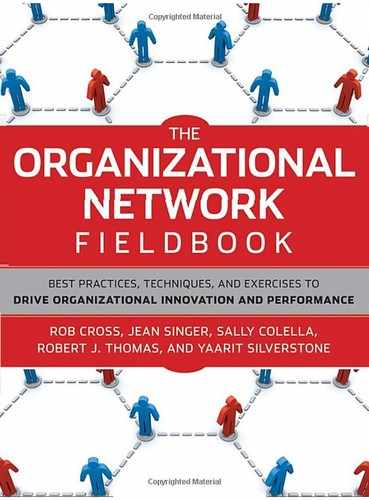Chapter 25. A NETWORK APPROACH TO ONBOARDING
Michel Buffet, Gregory A. Janicik, Maria Gallegos, Giulio Quaggiotto, and Lauren Ashwell
Many of us have experienced the roller coaster of joining a new organization— from the excitement of fresh opportunities to the frustration of not knowing how to accomplish simple tasks. These challenges affect not only individuals but also organizations. The U.S. Labor Department reports that more than 25 percent of all U.S. workers have been in their companies less than one year. Getting new hires up to speed quickly has obvious benefits for both employers and employees in terms of productivity and job satisfaction. Mellon Corporation research recently revealed that the time for new hires to reach full productivity ranges from 8 weeks for those in clerical roles to 26 weeks for executives. We believe that an essential component of ensuring that new hires quickly become productive and effective is helping them build a network of relationships.
The stakes are high for successful onboarding, in light of the large amounts that companies spend to recruit and train employees, especially at the executive level. Research has shown that a large proportion—as much as 40 percent—of new executive hires leave their organization within the first 18 months. This kind of turnover is a legitimate concern for organizations: some studies estimate that the cost for an organization to lose an executive is as high as 30 times his or her total compensation. Also, the loss of an executive can translate into a decrease in productivity among the remaining employees. A recent study by the Corporate Leadership Council shows that involuntary turnover among recently hired executives affects morale and confidence throughout an organization, which in turn can lead to increased turnover and lower engagement.
One factor that weighs heavily in an executive's decision to leave is his or her early experiences on the job. An executive hired to be a change agent, for instance, will not be able to make a smooth and satisfying transition if early on it becomes clear that he or she won't be given the resources to push for change or that the organization is not open to it. This early period is a critical time for new hires at all levels. In 2008, a survey conducted by the Aberdeen Group shows that 86 percent of employees make their decision to stay or leave in the first 12 months (Martin & Saba). To increase the likelihood that newly hired talent will find their early weeks and months to meet their expectations, many organizations have designed onboarding processes to ease and accelerate the breaking-in period. In fact, 68 percent of corporate human resources executives recently surveyed indicated that their companies have a formal onboarding process. Most of them, however, focus on imparting information to new hires through orientation activities, documents, and Intranet sites. Few of them stress the importance of relationship building.
New managers are often hired to bring in fresh perspectives and expertise. However, to gain buy-in, commitment, and even openness to their ideas, they need first to establish trust and build formal and informal relationships. If these managers are not quickly accepted and listened to, their valuable insights can be watered down or lost. Rollag, Parise, and Cross (2005) write that augmenting the traditional informational approach to onboarding with a relational component can accelerate a new hire's integration and his or her ability to become a productive contributor.
An onboarding program that goes beyond delivering information to facilitate relationship building will accomplish the following:
Provide opportunities for the transfer of knowledge between the new hire and the organization. Knowledge should flow both ways. Many orientation programs give new employees a very detailed view into the organization's ins and outs but fail to mine new employees' experience and business intelligence, even when they have been brought in as change agents.
Clarify role expectations as early as possible—preferably in the selection stage but at least before the first day on the job—and provide occasions for new executives to clarify goals and expectations with their direct reports.
Stimulate relationship building with people throughout the organization. The first two imperatives cannot be met effectively if relationship building is not at the center of an onboarding strategy. By establishing trusting and collaborative relationships with various organizational stakeholders early on, new employees are more likely to receive the unadulterated information they need to do their jobs and negotiate performance objectives for themselves and others.
In this chapter, we provide four examples of effective onboarding, each of which was informed by a belief in the importance of social networks and the crucial role they can play for new hires. The first two examples focus on executives. Michel Buffet follows the onboarding of a new leader at a biotech company, and Gregory Janicik presents a model to better understand a company's environment and readiness for change and describes its application at an architecture firm.
In both examples, the steps in the onboarding process follow a logical sequence:
Data are gathered about the environment the executive is joining, with particular attention paid to key stakeholders and the political lay of the land.
A coach or consultant works with the new leader to develop a network development and management plan, which includes input from key stakeholders.
The new hire takes action based on the plan.
The new leader, with help from others in the organization, tracks his or her evolving network, continually looking for opportunities to refine it.
The second two examples, each of which presents a discrete onboarding exercise rather than an entire process, pertain to new hires at all levels. Maria Gallegos and Giulio Quaggiotto describe a workshop that focuses on brokering introductions between new hires and key managers, and Lauren Ashwell presents an exercise designed to help new employees understand an organization's culture and tacit norms. Both of these practical approaches could be implemented as part of any onboarding program.
